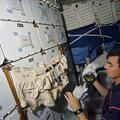
WIKIARCHIVES.SPACE
The Human Spaceflight Archive

This photo shows the aurora australis or souther lights. The multi-hued shafts of light, extending upward to 200 miles above the earth's surface, are caused by beams of energetic electrons colliding with the oxygen and nitrogen in the earth's upper atmosphere. The strong red glow occurs at the highest altitude where the air is least dense and composed mostly of oxygen. At lower altitudes, the greater density favors the green color, also produced by atomic oxygen. Sometimes at the bottom (the lowest altitude of the aurora) a pink border is produced by nitrogen. The aurora usually can be seen only in Arctic regions. However, because of the tilt of the magnetic axis of the space shuttle mission orbits. One of these regions is over eastern North American, and the second one is south of Australia. Since most shuttle launches occur in daytime, the North American region is in daylight, and the only auroras that can be seen are usually in the Southern Hemisphere.
Information
- Taken in
- Space
- Aŭtoro
- NASA
- Priskribo
-
This photo shows the aurora australis or souther lights. The multi-hued shafts of light, extending upward to 200 miles above the earth's surface, are caused by beams of energetic electrons colliding with the oxygen and nitrogen in the earth's upper atmosphere. The strong red glow occurs at the highest altitude where the air is least dense and composed mostly of oxygen. At lower altitudes, the greater density favors the green color, also produced by atomic oxygen. Sometimes at the bottom (the lowest altitude of the aurora) a pink border is produced by nitrogen. The aurora usually can be seen only in Arctic regions. However, because of the tilt of the magnetic axis of the space shuttle mission orbits. One of these regions is over eastern North American, and the second one is south of Australia. Since most shuttle launches occur in daytime, the North American region is in daylight, and the only auroras that can be seen are usually in the Southern Hemisphere.
- Created on
- Fotaroj
- US SPACE PROGRAM / SPACE SHUTTLE / MISSIONS / STS-62 / Mission Photos (Edited)
- Source link
- https://images.nasa.gov/search-results?q=sts-62&page=1&media=image,video,audio&yearStart=1990&yearEnd=1994
- Vizitoj
- 58
- Poento
- neniu taksado
- Taksu tiun foton
- License
- Public Domain
- Modified by WikiArchives
- No (original)
- Elŝutadoj
- 1
Potencigita per Piwigo

















































































































